8 lesser-known Trail hotels
- Greg Nesteroff
- Nov 9, 2020
- 15 min read
Updated: Jan 9
Trail has been home to several well-known hotels, including the Crown Point (which recently re-opened as the Crown Columbia), the Arlington (still in business, though its upper floors were removed in the late 1970s or early 1980s), the Kootenay (burned down 1978), and the Union (demolished by the city in 2019). But it has had lots of others, including some that are still standing and used for other purposes.
This is an incomplete list of the city’s little and lesser-known hotels, many of which were really glorified rooming houses. The only criteria for inclusion is that the buildings are either still around or pictures were readily available.
Aldridge, 901 Helena
This building, which is still standing at the corner of Helena and Cedar, was built by Dr. Corsan in 1896 and was Trail’s first hospital. Newspaper proprietor and future MP Billy Esling bought it and converted it into the Aldridge Hotel, which he named after smelter general manager Walter H. Aldridge. The first ad I can find for it is from the Nelson Daily News of July 22, 1916 showing a Mrs. A. Collier running it.

The ad continued to run through mid-October 1916. A cafe was added in April 1918 and an ad in the Trail News read:
The dining room of the Aldridge hotel has been turned into a first class all night cafe, where the people of Trail may secure the very best of foods. A merchants’ lunch is being served daily from 11:30 a.m. to 11 p.m. Short orders may be had at all hours. A lunch counter is being installed for the convenience of the quick lunch patrons. Try our merchants’ lunch at 40 cents. Lunch pails a specialty. Modern rooms, $9 to $18 per month.
Esling listed the hotel for sale or rent in 1918, but there were no immediate takers. He offered it to the City of Trail for $8,000 to use as a school or new city hall, but it doesn’t sound like council considered the offer too seriously, for the city clerk was instructed to reply that “the matter could not be considered at this time.”

Calgary Herald, June 29, 1918
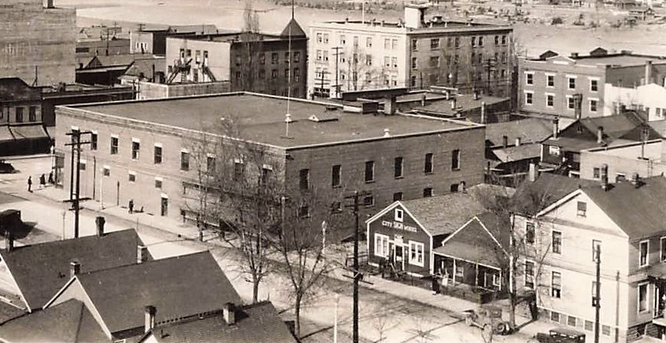
The Aldridge is seen above and below at right on ca. 1920s Hughes Brothers postcards. (Greg Nesteroff collection)
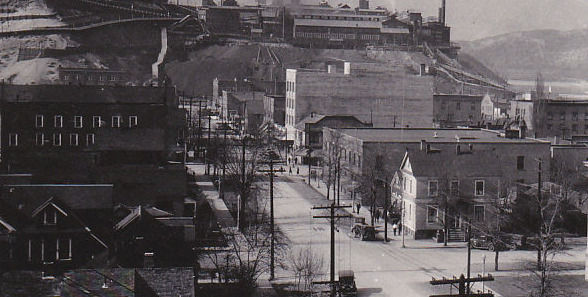
Instead, during the Spanish flu epidemic, Esling allowed the building to be used as an auxiliary medical ward, known as the Aldridge hospital. According to the Trail News of Nov. 6, 1918:
The Aldridge hotel, the use of which was gladly donated by William K. Esling, has been fitted up as an auxiliary hospital. At first it was manned largely by returned soldiers but they have been on duty night and day, and some of them are now down. Miss Willetson, a professional nurse was secured from Spokane on Wednesday and is in charge at the Aldridge.
It was not the only hotel so used; the Montana Hotel in the Gulch was also converted for that purpose. The Aldridge hospital closed on Dec. 7, 1918 with the remaining patients transferred to the main hospital kitty-corner at Cedar and Helena, which later became the Park Hotel (we’ll get to it in a bit).
Here is how the building appeared on fire insurance maps:
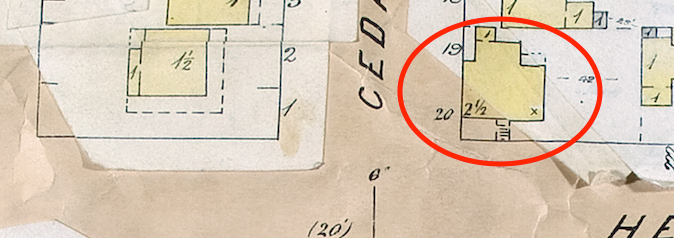
Sometime between 1897 and 1918.
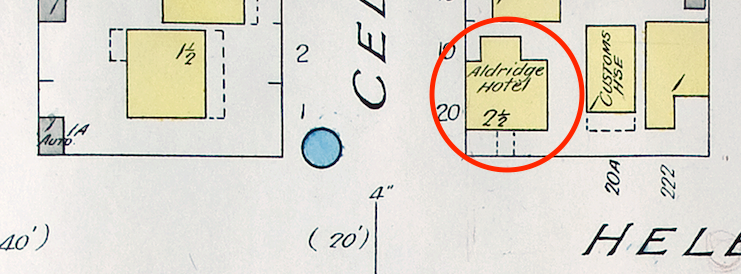
1918, now identified as the Aldridge Hotel.
In 1920, Esling had the building on the market again. This was his ad in the Trail News on May 28 of that year:
The Aldridge is for sale. Sixteen rooms, dining room and kitchen. Dining room can be converted into four nice rooms. Hot water heating system. Running water in all bed rooms. will be sold on terms. W.K. Esling
In 1922, Esling finally sold the building to Doctors Thom, Coghlin, and Ney, who converted the building into a clinic and nurses residence, as seen below.
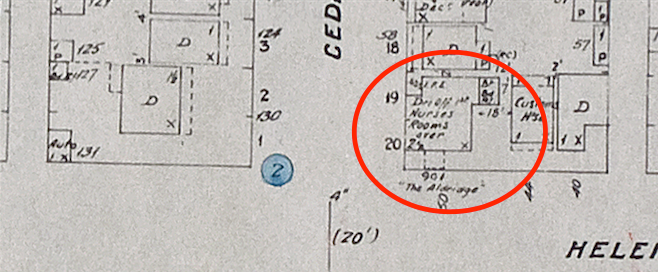
1925, now showing “doctors offices 1st [floor], nurses rooms over,” but still known as “The Aldridge.” An extension has been built on the northeast corner.

1935, now the Trail-Rossland clinic. Renamed the C.S. Williams Clinic in 1938 in tribute to one of its former members, it became the largest clinic in Trail.
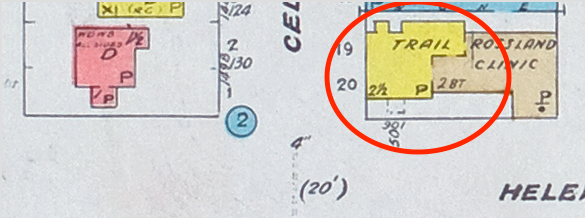
1953, now showing a multi-storey addition built to the east in 1949 at a cost of $65,000, providing 16 more consulting rooms and other facilities.
The Aldridge was the site of perhaps the most notorious crime in the city’s history.
On Feb. 6, 1925, Patrick Hanley, an insurance agency manager, entered the building and walked up to the second floor to see off-duty nurse Mildred Neilson. Hanley shot Neilson in the heart with a revolver, and then shot himself in the side. Neilson died, but Hanley survived and was charged with murder.
Neilson, 25, had been a nurse in Trail since the previous year and lived at the Aldridge. Her family had her body sent to Vancouver for burial. Smelter employees raised about $1,300 in a memorial fund which paid for a fountain at Ocean View Burial Park that is still there. The hospital was also able to buy a microscope in her name.
It emerged that Hanley returned from serving in World War I with serious psychological issues. He became infatuated with Neilson, who did not share his affection. After three trials, Hanley was convicted and sentenced to hang. However, his sentence was commuted to life imprisonment — thanks in no small part to a prominent Nelson woman who went to bat for him. (You can read all about it in Frances Welwood’s book, Passing Through Missing Pages.)
The C.S. Williams Clinic was in business for more than 50 years. However, as its doctors retired, the clinic shrank and finally merged with Medical Associates Clinic in the mid-1990s.
The remaining doctors donated the property to Selkirk College, who planned to renovate it but it never happened. The college sold the property to a man who planned to turn it into residential units, but this plan fell through as well. The building has been vacant ever since, and its future is uncertain. Demolition would be costly, and the development potential of the site is only modest.
Although the former Aldridge Hotel still shows some character at its attic level, the rest of its facade been almost totally neutered, with just a couple of second-storey windows left facing the Helena Street side. Still, it’s possibly the second oldest building left in Trail.

Access to the former Aldridge Hotel has been sealed off from Cedar and Helena streets. (Google Street View)
Bayview, 1150 Bay
The Bayview, built in 1952, is not to be confused with the much older Bay View, which was combined with the Pacific Hotel to form the original Union Hotel. The 1953 civic directory shows the address as vacant. I am not sure under what the building was initially used for or known as, but it shows up in 1960 as the MP Hotel, the initials of proprietor Mike Pistak. The name was changed to the Bayview in 1964.
I don’t know when it ceased to be a hotel, but it was no longer listed by 1971. Pistak owned the building until his death in 2017, and it remains in the family. In recent years the bottom floor has been home to Re/Max All Pro Realty and Kathleen Plaa, notary public, among other things. The upper levels have long been vacant. Retired city clerk Jamie Forbes was upstairs in the 1980s and says it has very large apartment-style rooms.
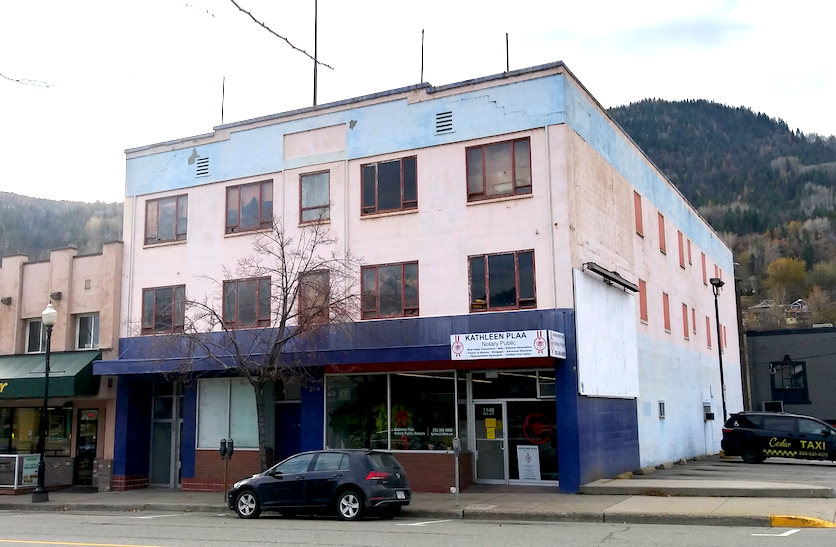
The former Bayview Hotel in 2020.
Dominion, Victoria Street
The Dominion, which is where the Trail Memorial Centre now stands (and/or its parking lot), was an amalgamation of two earlier hotels, the Wellington and the St. Elmo, both built in 1896.

A rare view of the Dominion Hotel, ca. 1910. (Greg Nesteroff collection)
The St. Elmo’s first owners were Hoyt and Craddock; Hoyt sold his share to James Dawson. The Wellington was built for Col. Alfred Jenkins on Block 3, Lots 18, 19, and 20.
Jenkins was a mining engineer and veteran of several wars, and could easily be goaded into telling battle stories. He sold the hotel to local brewer John Fluhrer in 1907, under a novel arrangement described by the Vancouver Province of Aug. 4, 1910:
The consideration was that he should be paid a pension for the rest of his life. [Fluhrer] expected that the old soldier would not last long to enjoy the pension, but he knew better, and lived to enjoy the annual competence for several years.
Jenkins died that year in San Francisco. Fluhrer bought the St. Elmo as well in late 1909 — reportedly the eighth change of ownership in two years — and combined the two hotels into the Dominion. After several months of renovations, there were 40 rooms, a bar downstairs in the old Wellington, a bowling alley (!) at the rear, and a “splendid shower bath with concrete floor, which is an innovation in hotel appointments in this city.”

Trail News, June 25, 1910
At some point in the next few years, the hotel was sold to Ransome and Campbell of Nelson, and then flipped to Thomas F. Gibson of Vancouver in 1913. It was for sale again a few months for $8,500. Gibson was listed as proprietor in 1914, but by 1915 it had been purchased by Stephen Walley and a partner named Green. Paul Larson was proprietor in 1918, but Walley took it over again the following year.
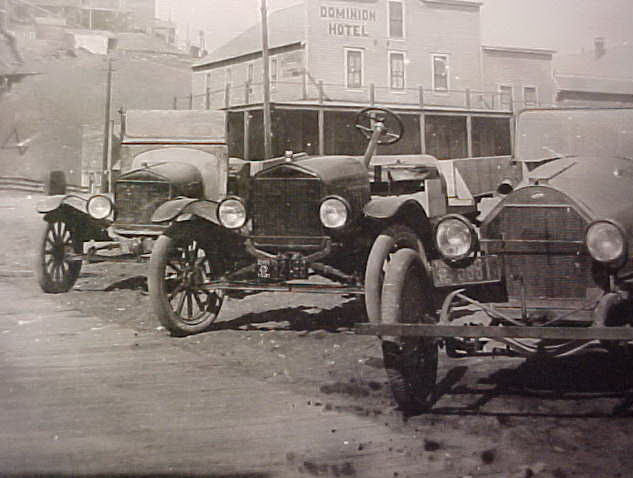
Postcard that sold on eBay a few years ago, showing the Dominion, ca. 1920s.
The Dominion was destroyed by fire one evening in August 1925. Walley, his wife, and 30 men rooming there escaped injury. The fire also destroyed a new brick garage that Walley was building, along with some cars.
The Trail News wrote: “Prospectors and miners, capitalists and smeltermen have come and gone, sharing shelter in the Dominion Hotel, studying its menu and wine lists. In its passing went one of the landmarks of Trail.”
Douglas, 821 Farwell
This two-storey hotel was built at the northeast corner of Farwell and Pine streets in 1925 by Evelyn Lawson Groutage, who would go on to become Trail’s mayor in 1934-35 and 1938-39. It was named after his eldest child, Douglas (1907-94).
It was one of the largest hotels in Trail, with 138 rooms and apartments, but because Evelyn was a devout Baptist, the Douglas didn’t have a pub, and alcohol was banned from the premises.

Douglas Hotel, ca. 1920s, on a Hughes Bros postcard. A datestone above the entrance on the Farwell Street side reads: DOUGLAS 19–BLK–25. (Greg Nesteroff collection)

Douglas Hotel, ca. 1930s or ‘40s. (Greg Nesteroff collection)
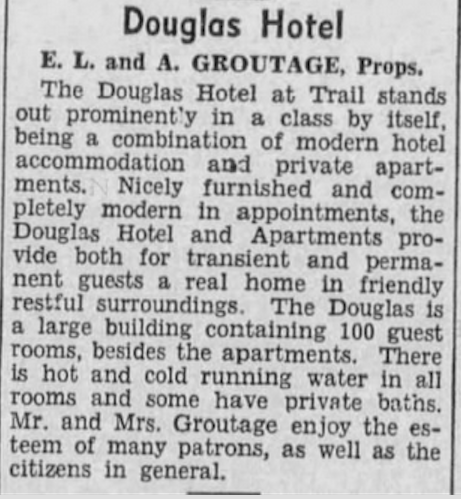
The Vancouver Sun, Jan. 16, 1937
The Douglas remained in the Groutage family for decades, but was up for sale in 1955 with an asking price of $60,000. H.R. Hardington was then the manager.
The hotel was adjacent to the railway tracks that crossed in front of it to the CPR depot across the street (now the site of Ferraro Foods). In 1963, the tracks were removed, and late the following year Super-Valu bought the Douglas. The building was demolished in 1965 to make room for a parking lot.
In 1980, a new building went up on the site. The Regional District of Kootenay Boundary had its offices on the second floor until 1990. It has also been home to various businesses, including Valu Office Supplies from 2003-17, and now Elevate Sport & Health and Movin’ Mountains therapy services
Melrose, 1200 Bay
Said to have been built in 1912, then “damaged and repaired in the 1920s,” but I can’t find it dsssin the civic directories during the 1910s. The first sign of it is an ad in 1918, when it was called the Melrose apartments and offered for sale. The 1920 directory listed it as the “Melrose Room.” The manager, significantly, was Gee Bong. If the Melrose was an hotel at the time, then he was one of very few Chinese hotel proprietors in West Kootenay.

The Melrose Hotel, ca. 1965-66. The addition seen at centre left was a car lot office. (Trail Historical Society 3708)
The following year, the proprietor was Evenlyn Groutage, who went on to build the Douglas, as described above. His wife Agnes was listed as proprietor in 1924.
From 1925-28, the manager was Peter Kapak, who then bought the New Grand Hotel in Nelson, and sold the Melrose Rooms to Herbert and Eliza Lamb. The Lambs ran the Melrose for the rest of its existence. For the previous 20 years, Herbert had run a taxi business in Rossland. Herbert died in 1958, but Eliza continued on until 1967, when the building was demolished.
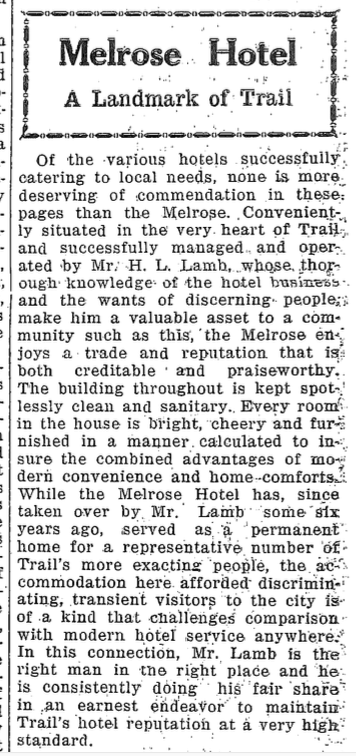
Trail Daily Times, Nov. 5, 1934
Park, 1500 Cedar and 850 Helena
Built as Trail’s second hospital by Dr. Patterson in 1907-08. Howard Ferguson had the woodwork contract while George White and sons did the brickwork. The doctor’s quarters faced Cedar Avenue, while the hospital fronted on Helena Street. Initially they were separate buildings. In 1910, to relieve overcrowding, the hospital was enlarged by converting the upper storey into a new ward.

Dr. Patterson residence on the right, ca. 1910s. (Trail Historical Society 0392)

Dr. Patterson home and hospital behind it, ca. 1910. (Trail Historical Society 0502)
Here is how it looked on the fire insurance maps.

This was sometime between 1907 and 1910. The pink around the yellow indicates both buildings were made of wood but veneered in brick.

As seen in 1918. The buildings are now joined and labelled a hospital. The west building now stands two and a half storeys tall, rather than one and a half.

The hospital, seen from Helena Street, after being raised to add another storey, ca. 1920s. Also seen is the connecting wing to the doctor’s residence. (Trail Historical Society 0503)
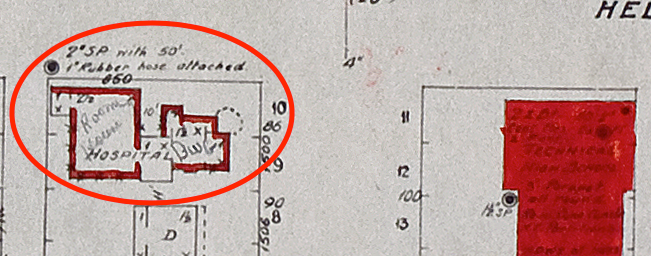
As seen in 1925. Pencilled over with “rooming house.” The building was converted into the Park Hotel around 1929 after the Trail-Tadanac Hospital was built on Victoria Street. While it was advertised as an hotel, rooming house is a more accurate description.
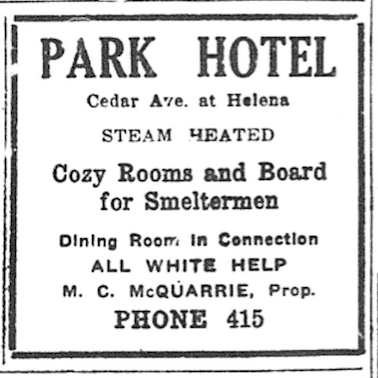
Trail Daily Times, Feb. 1, 1930. The Park would not have been the only business in town proud to offer “all white help.”
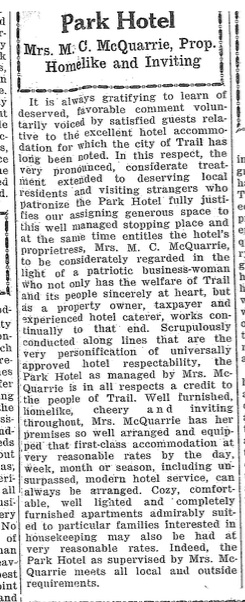
Trail Daily Times, Nov. 5, 1934

As seen in 1935, showing the Park apartments and hotel. The former doctor’s quarters have been expanded to the north.

As seen in 1953.
As of 1953, the proprietors were Luigi and Ada Tognotti and Amelia Dardi, who also lived there along with building owner Pietro Dardi (retired), Mary Dardi (an accountant at the Trail Times) and Fortunado Dardi (who worked at the Trail Mercantile). A number of tenants, including four single women, were also listed in the civic directory that year:
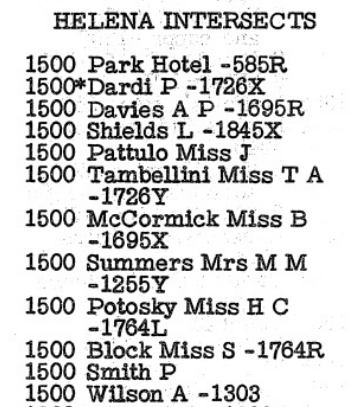
The 1963 directory showed 850 Helena as an annex to the hotel. As of that year, the proprietors were Luigi Tognotti and Mary Merlo. Tognotti, who also worked at the smelter, had since moved to Silvia Crescent, but Merlo was living in the hotel.

Above and below, the former doctor’s residence that was part of the Park Hotel, seen in 2020 at 1500 Cedar.

The Park Hotel was still listed in 1968, with Mary Merlo and Mrs. A. Dardi as the occupants. In 1979, the building was listed as the Park Apartments, of which there were apparently 36, but many of them were vacant.
The annex burned down, probably in the 1980s, and the Cedar Avenue reverted to medical offices. It’s presently vacant and for lease. A wooden fence has been built around it since these photos were taken.
Venezia, 924 Byers Lane or 907 Rossland Avenue
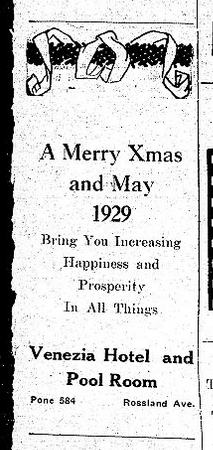
This hotel in the Gulch was where the Highway 3B-22 interchange is today. It was built on the site of another hotel, the Austrian, that burned down in 1908. The Austrian was built in 1896 or earlier and named for its proprietor, Mike Semich, who later sold it to Camille Lauriente. But Lauriente sold out six months later and went into the grocery business.
By one account, the rebuilt hotel was known as the Vannucci, but I can’t find it listed in the civic directories. Perhaps someone was misremembering the name. But nor can I find the Venezia mentioned until an ad, seen here, appeared in the Trail Times of Dec. 24, 1928. (It is the only ad I can find for the hotel at all.)
It was listed as the Venezia Boarding House in the 1937 civic directory, under the proprietorship of misses Neda Stensrud and Asta Hauge. The following year Stensrud was shown as the sole proprietor.

The Venezia Hotel is seen at left, date unknown. The Winchester Cigarettes ad is way bigger than the actual hotel sign! The building to the right is Bon Ton Tailors. (Trail Historical Society 0683)

The Venezia Hotel as seen in Cominco Magazine, November 1945, now with a balcony. Bon Ton Tailors and U&I Billiards are to the right. All the buildings and trees seen here are now gone.
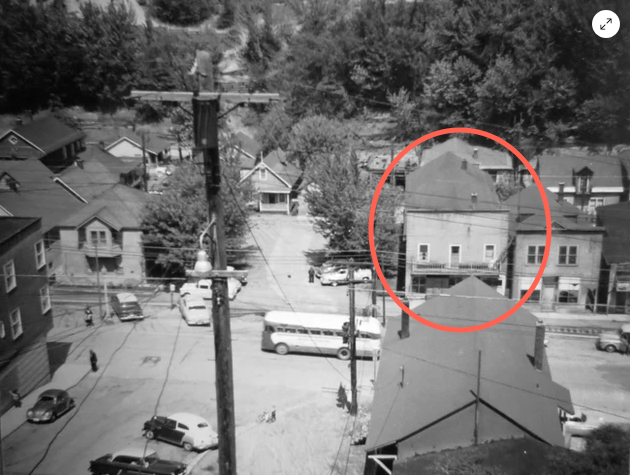
Another 1940s view of the Venezia, as seen from Glover Road. The edge of the still-standing (but now shuttered) Trail Hotel is seen at left. (Courtesy Jacqui Reed)
In 1939, Antonio Magliani took over the Venezia and ran it with his wife Pasqua and their children. They were the proprietors through at least 1963, and also lived there. Son Tino ran Trail Shoe Repair in the same building.
The building had both Byers Lane and Rossland Avenue street addresses, with the hotel at the Byers Lane address and, as of 1953, Mayo’s Taxi and the Venezia Cigar Store, run by Virgillio Giannini, showing up on Rossland Avenue side.
A sign about the history of the Gulch found in the Colombo Piazza lists the following as Venezia tenants, although I am not sure in what era: Rino Berno, Sante Berno, J.H. Clarke, Charles Field, Francis Hanham, Sante Maniago, Ken and Mabel McKimmie, Bruno Pagnucco, I. Petschauer, Primo Venturini, and Mike Zeffi. Only the Maglianis and McKimmie were listed as residing there in the 1953 directory; in 1963, it’s just the Maglianis and Emil Mucha. It was still listed as the Venezia Hotel, but not for long.
Around 1968, the building found a very different and interesting use: it was now home to a boat shop, the Trail Sport Marina (Tony Paolone and Joe Gabana, proprietors) and the Seth Martin Winter Shop, operated by the legendary Trail Smoke Eaters goaltender and John Paolone. From the Byers Lane side, it was known as the Magliani Bock. Mrs. Magliani and Emile Mucha still lived there.
Martin’s shop earned a mention in a Macleans magazine article in 1975 by Paul Grescoe.
He’s a Cominco fireman, but come autumn he operates the Seth Martin Winter Shop (“Hockey And Skiing Equipment — Skate Sharpening”) with John Paolone, a Cominco pipefitter ...
The afternoon I arrived, Martin was busy fitting skis at the back of the shop. One wall is done in Hockey Traditional: St. Louis pennants and plaques and autographed caricatures of NHL stars. Pinoke McIntyre introduced himself: ... he’d been a great hockey player ... He’s 40 now, a Cominco millwright who sharpens skates for Martin after work.
In 1979, 907 Rossland was still listed as the Magliani Block. In addition to Seth’s shop, it remained home to Emile Mucha as well as Tony Paolone, but the boat shop was gone. At 924 Byers Lane, Hugo Ramos was listed as the lone resident.
Seth’s shop was last listed at 907 Rossland in 1980. It then moved to Waneta Plaza. I asked Seth’s wife Bev about it, but she wasn’t aware the building had been the Venezia.
According to Trail of Memories, the hotel was torn down in the 1980s “to make way for a new road.” This would have been preparatory for the construction of the West Trail approach, which was not built until the early 1990s. Also long gone are the neighbouring buildings including Bon Ton Tailors, U&I Billiards, and several homes.
Sadly, all of the remaining homes on Byers Lane were also demolished in the early 2000s to build a truck chain-up area.
Victoria, 1197a Cedar and 1198 Bay
This hotel began life on Victoria Street, one of several in that area along with the Dominion (noted above). The first mention I can find of it is from January 1904, when Israel McDonald and William Sutherland applied for a liquor license. Subsequent proprietors included Michael Joseph, John Popovich, Frank Verzuh, and Augustus Mueller, who had the hotel moved to the corner of Cedar and Farwell streets in the fall of 1914.
By the following year, Joseph W. Rozeck was running it, initially solo, and then with partner Hans Gunstad. Rozeck left in early 1920s, but Gunstad continued to operate the Victoria until his retirement in 1945 and lived in the hotel until his death in 1950.

The Victoria Hotel is seen at right, ca. 1960s. (Trail Historical Society 1967)
Subsequently, Charles and Julia Palek ran the hotel, which also listed an annex at 1198 Bay, operated in the 1940s by Bertha Fyle, and as of 1953 by Fyle and R. Anderson. The annex was home to a brothel known as the Green Door. The following appeared in the Trail Daily Times of Jan. 27, 1948 under the banner headline “City council declares war on local prostitutes.”
Acting quickly and decisively on a letter from the C.S. Williams clinic pointing to an increasing incidence of infection from venereal diseases, Trail city council last night ordered that prostitutes, alleged to be operating in the building known as the Victoria Annex, 1198 Bay Ave., be “run out of town.”
I don’t know if their edict had any effect.
From at least 1953 to 1964, Joe Simonetta was the Victoria’s proprietor. The building had commercial spaces on the first floor, occupied in the 1950s and ‘60s by such businesses as Bon Ton Men’s Wear, Bill’s Cafe, and Daw Radio and TV Service.
The Victoria block was demolished in 1965 or 1966. It was in the latter year that the building now home to the Trail branch of Kootenay Savings Credit Union was built on the site.
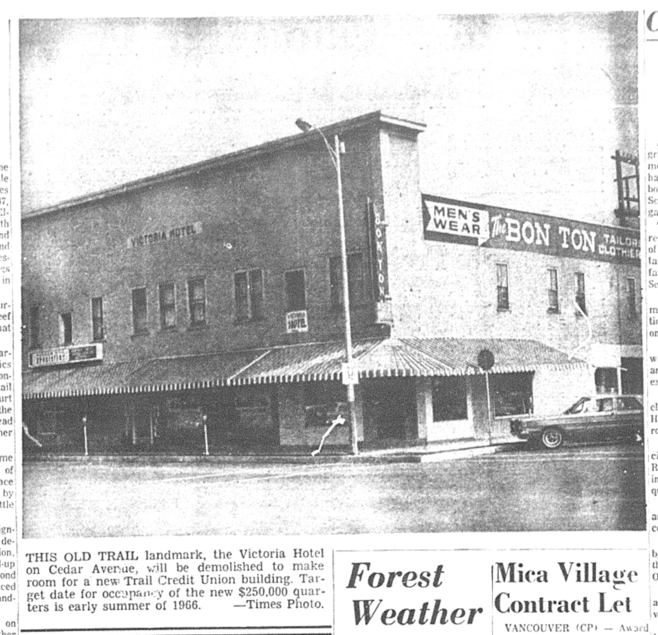
Trail Daily Times, Aug. 6, 1965
— With thanks to Jamie Forbes
Updated Jan. 20, 2021 to add the fire insurance plans; on Jan. 21, 2021 to add historic photos of the Park Hotel; and on Jan. 25, 2021 to add details about the murder of Mildred Neilson; and on June 24, 2021 to add the photo of the Victoria Hotel just prior to its demolition and the item about the Victoria annex being a brothel; and on Nov. 7, 2021 to add the 1916 ad for the Aldridge; and on June 2, 2022 to add the 1940s pictures of the Venezia; and on Aug. 30, 2022 to correct the location of the Venezia; and on Sept. 5, 2022 to add how the Venezia later became the Seth Martin Winter Shop; and on Jan. 16, 2024 to add a few more details about the Aldridge; and on Nov. 26, 2024 to add still more details about the Aldridge and another about the Melrose; and on Jan. 9, 2025 to add the ad for the Venezia.
"Neutered" is exactly the right word to describe the Aldridge!
Thanks, Dave! Will make that addition.
The small building to the left of the Melrose Hotel was a car lot office 1959!
Many thanks, Jim. BC Assessment indicates the building was constructed in 1953. The civic directory for that year shows the property as vacant. No sign of it as the MP or the Bayview in the 1956 or 1958 phone books. It shows up for the first time as the MP in the 1960 phone book. Also under that name in 1962 and 1963. The name changed to Bayview in 1964. I will amend the post accordingly.
Back when I was a kid/teenager in Trail in the late 40s and early 50s I can remember that Mike Pistak built a hotel he called the MP Hotel that was located where your catalogued Bayview is shown. I can only assume that somewhere along the way Mr. Pistak changed the name from MP to Bayview. During the mid 1950s a Quebecois man showed up in Trail and opened a traditional eastern Ontario/Quebec chip (i.e. french fry) wagon in an old step van. He had it set up at the MP hotel and on the nights of Smokies home games stole intermission business from the Cominco Arena because of the quality and price of his product.
Jim Sadler